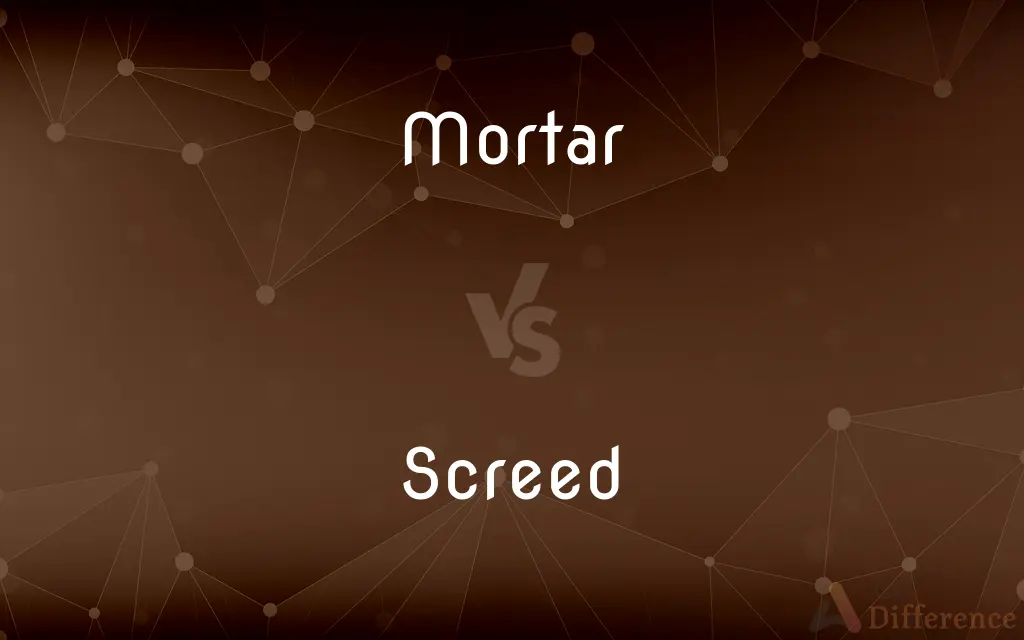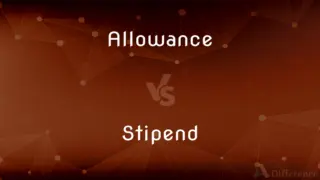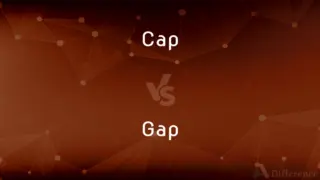Mortar vs. Screed — What's the Difference?
By Maham Liaqat & Fiza Rafique — Updated on March 26, 2024
Mortar is a bonding agent for building materials like bricks, while screed is a leveling layer applied to a floor base to ensure a flat surface.

Difference Between Mortar and Screed
Table of Contents
ADVERTISEMENT
Key Differences
Mortar is a mixture used in construction to bond bricks, stones, and other masonry units together, forming a compact and unified structure. It typically consists of sand, a binder like cement or lime, and water. Screed, on the other hand, is applied on top of a concrete floor base or subfloor to create a smooth, level surface for the final floor covering; it is usually made from a similar mix of cement and sand but has a different consistency and purpose.
Mortar's primary function is to fill the gaps between bricks or stones and to secure them in place, providing structural integrity and preventing the penetration of moisture. Screed is used to ensure that floors are level and to provide a suitable base for laying floor tiles, wood flooring, or other finishes. It can also include additional compounds to improve strength, drying time, and moisture resistance.
The composition of mortar can vary to suit different types of masonry work, with variations in the sand-to-cement ratio and the addition of specific additives to enhance durability, workability, and setting time. Screed, while also adjustable in terms of composition, is often designed for greater durability and to withstand the wear and tear of foot traffic, even though it's usually covered by another flooring material.
Mortar is applied in relatively thin layers to adhere bricks or stones to each other, and its workability is crucial for the ease of application and the strength of the bond it forms. Screed is applied in thicker layers that need to be smooth and level, requiring a different technique for application and finishing to achieve a flat surface.
While mortar plays a critical role in the structural aspect of a building by bonding construction materials together, screed is essential for the aesthetic and functional quality of the floor. It ensures a level and sturdy base that affects the appearance, feel, and longevity of the floor covering that goes on top of it.
ADVERTISEMENT
Comparison Chart
Composition
Sand, cement/lime, water
Sand, cement, water, sometimes fine aggregates
Primary Use
Bonding bricks, stones, masonry units
Leveling floor surfaces
Application
Thin layers between masonry units
Thick layer on floor base
Consistency
Workable paste
Smoother, flowable mix
Function
Structural integrity, moisture prevention
Surface leveling, base for floor finishes
Variability
Different mixes for various masonry needs
Adjusted for durability, drying time
Installation Technique
Applied with trowel, requires skill for even application
Spread and leveled to ensure flat surface
Compare with Definitions
Mortar
Mixture for bonding construction materials.
Mortar was used to secure the bricks in the wall.
Screed
Creates flat surfaces for flooring.
The contractor poured screed over the concrete base to level it.
Mortar
Essential for building integrity.
The structural strength of the wall relies on the quality of the mortar.
Screed
Prepares floors for final covering.
Before laying the tiles, screed was applied to ensure a smooth base.
Mortar
Adapts to different construction needs.
The builder chose a mortar mix suitable for outdoor conditions.
Screed
Can be modified for specific uses.
The screed mix was adjusted to speed up the drying process.
Mortar
Withstands environmental stress.
The ancient mortar between the stones has lasted centuries.
Screed
Contributes to the aesthetic of floors.
Although it will be covered, the screed needs to be perfectly smooth for the best finish.
Mortar
Prevents water penetration.
Mortar in the shower area was mixed with a waterproofing agent.
Screed
Made to withstand foot traffic.
The screed must be durable to support the heavy footfall in the hallway.
Mortar
A short smooth-bore gun for firing shells (technically called bombs) at high angles
Mortars and machine guns
Nine civilians died in a horrific mortar attack
Screed
Screed has three meanings in building construction: a flat board (screed board, floating screed) or a purpose-made aluminium tool used to smooth and to "true" materials like concrete, stucco and plaster after they have been placed on a surface or to assist in flattening; a strip of plaster or wood applied to a surface to act as a guide for a screed tool (screed rail, screed strip, screed batten); the material itself which has been flattened with a screed (screed coat). In the UK, screed has also come to describe a thin, top layer of material (sand and cement, magnesite or calcium sulphate), poured in situ on top of the structural concrete or insulation, on top of which other finishing materials can be applied, or the structural material can be left bare to achieve a raw effect.
Mortar
A cup-shaped receptacle in which ingredients are crushed or ground, used in cooking or pharmacy
A pestle and mortar
Screed
A long monotonous speech or piece of writing.
Mortar
A mixture of lime with cement, sand, and water, used in building to bond bricks or stones.
Screed
A strip of wood, plaster, or metal placed on a wall or pavement as a guide for the even application of plaster or concrete.
Mortar
Attack or bombard with a mortar
At first light the mortaring and sniping started
The Commando positions were being heavily mortared
Screed
A layer or strip of material used to level off a horizontal surface such as a floor.
Mortar
Fix or join using mortar
The pipe can be mortared in place
Screed
A smooth final surface of a substance, such as concrete, applied to a floor.
Mortar
A vessel in which substances are crushed or ground with a pestle.
Screed
A piece or narrow strip cut or torn off from a larger whole; a shred.
Mortar
A machine in which materials are ground and blended or crushed.
Screed
A piece of land, especially one that is narrow.
Mortar
A portable, usually muzzleloading cannon used to fire shells at low velocities, short ranges, and high trajectories.
Screed
A rent, a tear.
Mortar
A shell fired by such a cannon.
Screed
A piece of writing (such as an article, letter, or list) or a speech, especially if long.
Mortar
Any of several similar devices, such as one that shoots life lines across a stretch of water.
Screed
(by extension) A speech or piece of writing which contains angry and extended criticism.
Mortar
A short, usually stationary, muzzleloading cannon used from the 1700s to early 1900s to fire large round shells at low velocities, short ranges, and high trajectories.
Screed
Chiefly in the plural form screeds: a large quantity.
Mortar
Any of various bonding materials used in masonry, surfacing, and plastering, especially a mixture of cement or lime, sand, and water that hardens in place and is used to bind together bricks or stones.
Screed
Senses relating to building construction and masonry.
Mortar
To bombard with mortar shells.
Screed
A tool, usually a long strip of wood or other material, placed on a floor to be covered with concrete, a wall to be plastered, etc., as a guide for producing a smooth, flat surface.
Mortar
To plaster or join with mortar.
Screed
A tool such as a long strip of wood or other material which is drawn over a wet layer of concrete, plaster, etc., to make it smooth and flat; also, a machine that achieves this effect; a screeder.
Mortar
(uncountable) A mixture of lime or cement, sand and water used for bonding building blocks.
Screed
A smooth, flat layer of concrete, plaster, or similar material, especially if acting as a base for paving stones, tiles, wooden planks, etc.
Mortar
(countable) A muzzle-loading, indirect fire weapon with a tube length of 10 to 20 calibers and designed to lob shells at very steep trajectories.
Screed
A (discordant) sound or tune played on bagpipes, a fiddle, or a pipe.
Mortar
(countable) A hollow vessel used to pound, crush, rub, grind or mix ingredients with a pestle.
Screed
The sound of something scratching or tearing.
Mortar
(countable) In paper milling, a trough in which material is hammered.
Screed
To rend, to shred, to tear.
Mortar
(transitive) To use mortar or plaster to join two things together.
Screed
To read or repeat from memory fluently or glibly; to reel off.
Mortar
(transitive) To pound in a mortar.
Screed
To use a screed to produce a smooth, flat surface of concrete, plaster, or similar material; also (generally) to put down a layer of concrete, plaster, etc.
Mortar
To fire a mortar (weapon).
Screed
To become rent or torn.
Mortar
To attack (someone or something) using a mortar (weapon).
The insurgents snuck up close and mortared the base last night.
Screed
To play bagpipes, a fiddle, or a pipe.
Mortar
A strong vessel, commonly in form of an inverted bell, in which substances are pounded or rubbed with a pestle.
Screed
(intransitive) To make a discordant or harsh scratching or tearing sound.
Mortar
A short piece of ordnance, used for throwing bombs, carcasses, shells, etc., at high angles of elevation, as 45°, and even higher; - so named from its resemblance in shape to the utensil above described.
Screed
To play (a sound or tune) on bagpipes, a fiddle, or a pipe.
Mortar
A building material made by mixing lime, cement, or plaster of Paris, with sand, water, and sometimes other materials; - used in masonry for joining stones, bricks, etc., also for plastering, and in other ways.
Screed
Strewn with scree.
We clambered up a screed slope.
Mortar
A chamber lamp or light.
Screed
A strip of plaster of the thickness proposed for the coat, applied to the wall at intervals of four or five feet, as a guide.
Mortar
To plaster or make fast with mortar.
Screed
A fragment; a portion; a shred.
Mortar
A muzzle-loading high-angle gun with a short barrel that fires shells at high elevations for a short range
Screed
A breach or rent; a breaking forth into a loud, shrill sound; as, martial screeds.
Mortar
Used as a bond in masonry or for covering a wall
Screed
An harangue; a long tirade on any subject.
The old carl gae them a screed of doctrine; ye might have heard him a mile down the wind.
Mortar
A bowl-shaped vessel in which substances can be ground and mixed with a pestle
Screed
A long monotonous harangue
Mortar
Plaster with mortar;
Mortar the wall
Screed
A long piece of writing
Screed
An accurately levelled strip of material placed on a wall or floor as guide for the even application of plaster or concrete
Common Curiosities
What is mortar used for in construction?
To bond bricks, stones, and other masonry units together.
Can screed be used as a final floor surface?
Yes, in some cases, it's finished to serve as the final flooring.
Can mortar be used instead of screed for leveling floors?
Generally, no, as mortar and screed have different compositions and purposes.
How does the composition of mortar and screed differ?
Both contain sand and cement, but mortar may include lime and has a different consistency; screed may have fine aggregates for strength.
Is there a difference in application techniques between mortar and screed?
Yes, mortar is applied in thin layers with a trowel, while screed is spread and leveled for a flat surface.
Why is screed applied to a floor?
To create a smooth, level surface for laying floor coverings.
What role does screed play in floor installation?
It ensures the floor is level and provides a suitable base for final floor coverings.
How does the durability of mortar and screed impact a building?
It affects the longevity and integrity of structures and floor finishes.
How do the properties of mortar and screed enhance their specific uses?
Mortar's adhesive properties secure masonry units, while screed's leveling properties prepare floors for finishing.
Can the consistency of screed be modified?
Yes, to suit different types of floor finishes and installation requirements.
Can screed include additives?
Yes, additives can be included to improve strength, drying time, and moisture resistance.
What affects the choice of mortar type for a project?
The type of masonry work, environmental conditions, and desired characteristics like drying time and strength.
How do variations in screed composition affect its use?
Adjustments can be made for specific needs like faster drying times or increased durability.
Why is workability important for mortar?
It affects ease of application and the strength of the bond between masonry units.
Why might a waterproofing agent be added to mortar?
To prevent moisture penetration in areas exposed to water.
Share Your Discovery

Previous Comparison
Allowance vs. Stipend
Next Comparison
Cap vs. GapAuthor Spotlight
Written by
Maham LiaqatCo-written by
Fiza RafiqueFiza Rafique is a skilled content writer at AskDifference.com, where she meticulously refines and enhances written pieces. Drawing from her vast editorial expertise, Fiza ensures clarity, accuracy, and precision in every article. Passionate about language, she continually seeks to elevate the quality of content for readers worldwide.














































